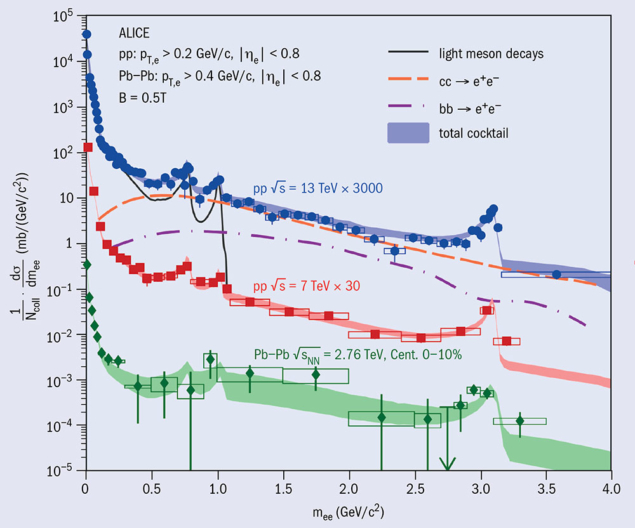
A report from the ALICE experiment
One of the main objectives of the ALICE physics programme for future LHC runs is the precise measurement of the e+e− (dielectron) invariant-mass continuum produced in heavy-ion collisions. In contrast to strongly interacting hadronic probes, dielectrons provide an unperturbed view into the quark–gluon plasma (QGP), a phase of deconfined quarks and gluons that is produced in such collisions. For example, they will allow physicists to determine the initial temperature of the QGP and to study the effects of the predicted restoration of chiral symmetry. In order to perform these measurements, important upgrades to the ALICE detector system are underway, most notably a new inner tracking system and a new readout system for the time projection chamber.
Meanwhile, the ALICE collaboration has also analysed the proton–proton (pp) and lead–lead (Pb–Pb) collision data recorded so far during LHC Runs 1 and 2. The results, which have recently been submitted for publication, provide new physics insights, in particular into the production of heavy quarks (charm and beauty) in pp collisions at centre-of-mass energies of 7 and 13 TeV. The measured invariant-mass spectrum of dielectrons (see figure) has been found to be in good agreement with the expected distribution of dielectrons from decays of light mesons and J/ψ, as well as semileptonic decays of correlated heavy-flavour pairs. The Pb–Pb results, recorded at a centre-of-mass energy of 2.76 TeV per nucleon–nucleon pair, are not yet sensitive enough to quantify the presence of thermal radiation and signs of chiral symmetry restoration on top of the vacuum expectation.
The results obtained in pp collisions at 13 TeV provide the first measurements of charm and beauty production cross sections at mid-rapidity integrated over all transverse momenta at the current highest LHC energy. Fitting the data with two different models of heavy-flavour production (PYTHIA 6.4 and POWHEG), ALICE observes significant differences in the obtained charm cross sections at both investigated collision energies. The difference arises from different rapidity correlations between charm and anti-charm quarks in the two calculations. Hence, the data provide crucial input to improve models of charm production that is complementary to single charmed-hadron measurements.
In addition, the distance of the closest approach (dca) of the electrons to the collision vertex has been successfully used in the analysis of pp collisions at 7 TeV to distinguish displaced dielectrons from open-heavy flavour decays and prompt decays of light hadrons. This is an important test as the dca will be a crucial tool to isolate a thermal signal in the mass region 1–3 GeV/c2 in the data that will be collected in LHC Runs 3 and 4 (starting in 2021). Part of the data will be recorded with the magnetic field of the central barrel solenoid reduced from 0.5 to 0.2 T in order to further increase the acceptance of dielectrons with low mass and transverse momentum.
Further reading
ALICE Collaboration 2018 arXiv:1805.04391, arXiv:1805.04407 and arXiv:1807.00923.





